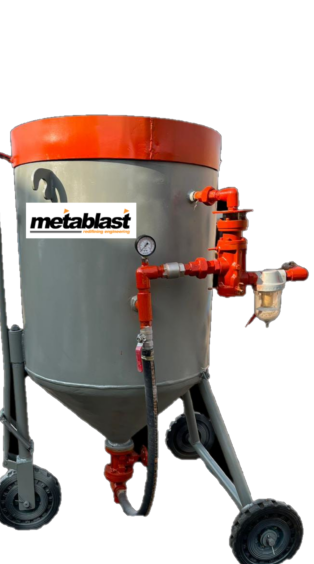
Pneumatic or air shot blasting machines, including pressure blasters and suction blasters, operate on the principle of using compressed air to propel abrasive media onto the surface of a workpiece for cleaning, finishing, or preparation. These machines differ from airless shot blasting machines in several ways, primarily in their method of propelling abrasive media and the types of components they can effectively blast.
Pneumatic Shot Blasting Machines: These machines use compressed air to propel abrasive media onto the surface of the workpiece. The abrasive media is mixed with compressed air and accelerated through a blast nozzle to impact the surface, removing contaminants and achieving the desired surface finish.
Airless Shot Blasting Machines: In contrast, airless shot blasting machines use centrifugal force or mechanical propulsion systems, such as wheel turbines or blast wheels, to propel abrasive media onto the workpiece surface. These machines do not rely on compressed air to propel the abrasive media, offering different blasting characteristics and capabilities.
Metablast's pneumatic shot blasting machines, including pressure blasters and suction blasters, are versatile and suitable for a wide range of components across various industries. These may include:
Metal castings
Automotive parts (e.g., engine components, chassis parts)
Aerospace components (e.g., aircraft engine parts, landing gear)
Structural steel (e.g., beams, columns)
Foundry products
Pipe and tube sections
Concrete surfaces
Stone and masonry surfaces
And more
Suction Blaster: In a suction blaster, abrasive media is drawn into the blast gun using suction created by compressed air. The abrasive media is mixed with compressed air and propelled onto the workpiece surface through the blast nozzle. Suction blasters are typically used for lighter blasting applications and are suitable for smaller workpieces or areas that require more precision.
Pressure Blaster: In a pressure blaster, abrasive media is stored in a pressurized vessel and propelled onto the workpiece surface using compressed air. The abrasive media is pressurized within the vessel and forced through the blast nozzle at high velocity. Pressure blasters are suitable for heavier blasting applications and can handle larger workpieces or areas that require more aggressive surface preparation.
In summary, pneumatic or air shot blasting machines, such as pressure blasters and suction blasters, offer versatility and effectiveness in surface preparation, cleaning, and finishing applications across various industries. These machines differ from airless shot blasting machines in their method of propelling abrasive media and are suitable for blasting a wide range of components with different sizes, shapes, and surface requirements.